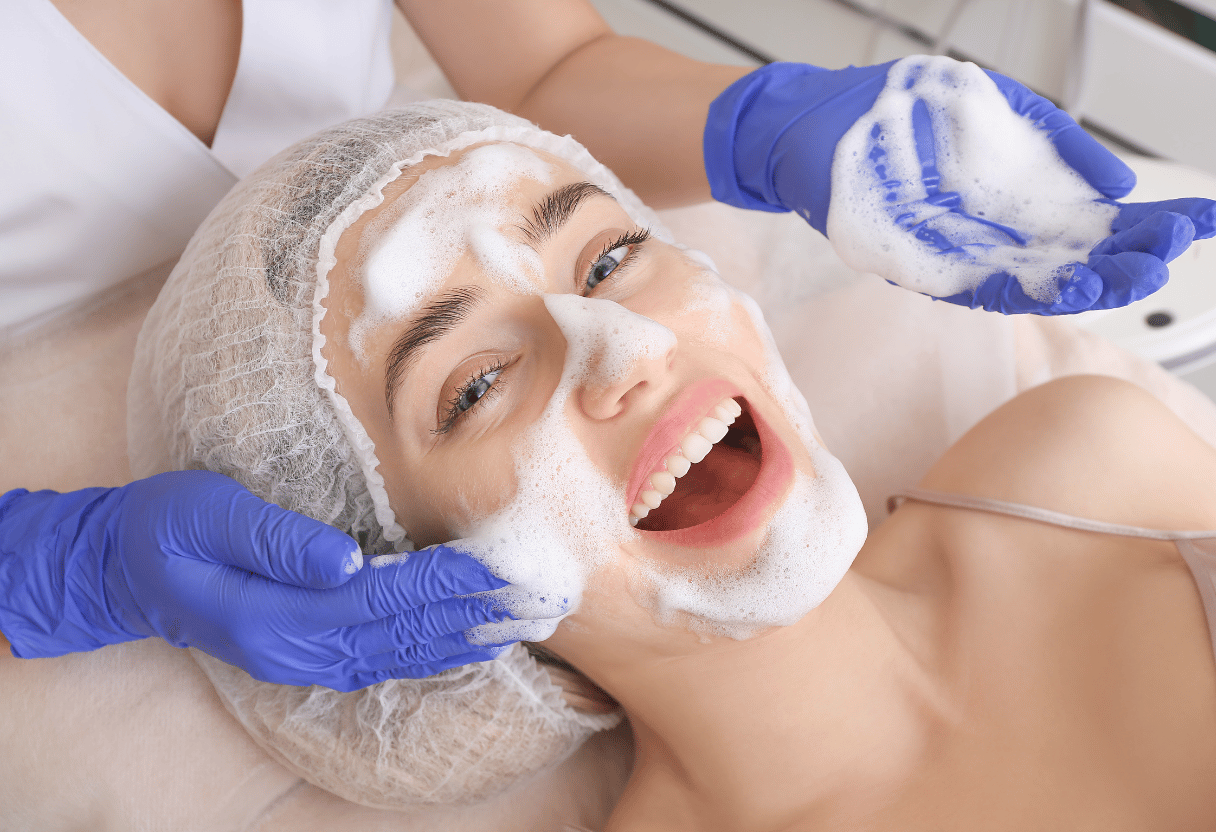What Is Double Cleansing On Your Skin?
Many skincare enthusiasts swear by the double cleansing method to achieve a thorough cleanse that leaves your skin looking and feeling its best. This technique involves using an oil-based cleanser followed by a water-based cleanser to effectively remove makeup, sunscreen, and impurities. By adopting double cleansing into your routine, you can reduce the risk of clogged pores and breakouts while promoting a clearer, healthier complexion. In this guide, you’ll learn how to master double cleansing for optimal results and the right products suited for your skin type.
Table of Contents

Key Takeaways:
- Double Cleansing involves two steps: an oil-based cleanser followed by a water-based cleanser to thoroughly remove makeup, sunscreen, and impurities.
- Start with an oil-based cleanser to dissolve makeup and oil-based debris, ensuring a clean slate for your skin.
- The second step, using a water-based cleanser, helps to eliminate any leftover residue, leaving your skin fresh and clean.
- Double cleansing is beneficial for all skin types, particularly for those who wear makeup regularly or have oily skin.
- Incorporating double cleansing into your nightly routine can lead to a clearer complexion and enhanced skin health over time.
Understanding Double Cleansing
What is Double Cleansing?
Clearly, double cleansing is a two-step skincare method designed to provide a deep clean for your skin. The first step typically involves an oil-based cleanser, which effectively dissolves makeup, sunscreen, and excess sebum. Following this, a water-based cleanser is used to remove any remaining impurities, sweat, and dirt from the skin’s surface. For products that support this method, explore 5 Best Double Cleansing Kits for Clean Skin.
This approach is particularly beneficial for individuals with makeup on, or those living in urban environments where pollution levels are higher. By using double cleansing, you ensure that your pores are thoroughly cleaned, helping to reduce breakouts and maintain a healthy complexion.
Types of Cleansers
What you choose for your cleansing routine can significantly impact your skin’s health. The types of cleansers vary widely, catering to different skin types and concerns. Below is an overview of some common types of cleansers:
| Type of Cleanser | Description |
|---|---|
| Oil Cleanser | Great for dissolving makeup and oils without stripping the skin. |
| Foam Cleanser | Ideal for oily or combination skin, it helps to remove excess shine. |
| Cream Cleanser | Suitable for dry or sensitive skin, offering hydration while cleansing. |
| Gel Cleanser | Effective for acne-prone skin, providing a deep clean with a lightweight texture. |
| Micellar Water | A gentle alternative that cleanses without the need for rinsing. |
Understanding the variety of cleansers available allows you to select the one that best suits your skin type and daily needs. To find cleansers tailored to your preferences, check out 5 Best Cleansers for Every Skin Type.
Customizing Your Routine
Knowing how different types of cleansers work can help you customize your double cleansing routine. Below is a summary of the most suitable cleansers based on skin type:
| Type of Cleanser | Best For |
|---|---|
| Oil Cleanser | All skin types; especially effective for heavy makeup wearers. |
| Foam Cleanser | Oily skin; effective in targeting excess oils. |
| Cream Cleanser | Dry and sensitive skin; hydrating and gentle. |
| Gel Cleanser | Acne-prone skin; helps reduce the appearance of breakouts. |
| Micellar Water | Quick and easy cleansing for on-the-go lifestyles. |
Choosing the right cleanser ensures your skin remains fresh and clear. For top-rated options, explore 5 Best Oil-Based and Water-Based Cleansers for Double Cleansing.
Understanding your skin’s needs is the first step toward achieving a radiant complexion.n remains fresh and clear. Understanding your skin’s needs is the first step toward achieving a radiant complexion.

Step-by-Step Guide to Double Cleansing
You may be wondering how to effectively carry out a double cleansing routine. This method can transform your skincare game, leaving your skin feeling clean and refreshed. The basic idea is to use two types of cleansers: an oil-based cleanser followed by a water-based cleanser. To help you navigate through the process, we’ve broken it down into easy steps:
| Step | Description |
|---|---|
| 1. First Cleanse: Oil-Based Cleanser | Use an oil-based cleanser to dissolve makeup, sunscreen, and excess oil. |
| 2. Second Cleanse: Water-Based Cleanser | Follow up with a water-based cleanser to remove any remaining impurities. |
First Cleanse: Oil-Based Cleanser
For the first step in your double cleansing journey, you’ll need to select an oil-based cleanser. This step is designed to break down oil-based products, such as makeup and sunscreen, which means it’s imperative to apply this cleanser to dry skin. Massage the oil gently onto your face in circular motions, focusing on areas where makeup is most concentrated. You’ll feel the product working to lift away impurities, making it easier for the second cleanser to do its job effectively. For effective options, explore 5 Best Oil-Based Cleansers for Makeup Removal.
For optimal results, you should spend at least a minute on this step. Once you feel that your skin is free of makeup, rinse off the oil cleanser with warm water. This step not only preps your skin for the next cleanse but also helps in maintaining your skin’s moisture balance. You can explore more about this technique in The Ultimate Guide to Double Cleansing.
Second Cleanse: Water-Based Cleanser
Assuming you’ve successfully completed your first cleanse, it’s time to move on to your water-based cleanser. This step is imperative for removing any leftover residue from the oil-based cleanser as well as sweat and dirt that may have accumulated throughout the day. Choose a gentle cleanser suitable for your skin type—this will enhance the effectiveness of your skincare routine. Apply the cleanser to damp skin, working it delicately into your face to ensure that every impurity is washed away. For recommendations, try 5 Best Water-Based Cleansers for Clear Skin.
The second cleanse sets the stage for better absorption of your serums and moisturizers. By thoroughly cleansing your skin, you allow your skincare products to penetrate deeper and deliver their full benefits. This step not only helps in maintaining your skin’s texture but also reduces the risk of clogged pores, which can lead to breakouts. Embracing this two-step process can make a significant difference in your daily skincare regimen. To master this technique, check out 5 Best Tips for Successful Double Cleansing.

Tips for Effective Double Cleansing
To ensure your double cleansing routine is both effective and beneficial for your skin, incorporate the following tips into your regimen. Firstly, always start with an oil-based cleanser to properly dissolve makeup, sunscreen, and accumulated impurities. This method effectively preps your skin for the second step, which should involve a gentle water-based cleanser. You might also consider selecting products suited specifically to your skin type, whether it’s oily, dry, or sensitive, as this will significantly enhance your cleansing experience. Here are some additional pointers:
- Take your time when cleansing; dedicate at least 30 seconds to each cleanser.
- Use lukewarm water to avoid stripping your skin of its natural oils.
- Pat your skin dry with a clean towel after cleansing, avoiding any harsh rubbing.
- Consider using a facial brush for deeper cleansing if your skin can tolerate it.
Recognizing the right products and techniques can greatly elevate your skincare routine. For more detailed insight, check out The Ultimate Guide on How to Double Cleanse for Clean ….
Choosing the Right Products
Clearly, selecting the appropriate products for double cleansing is vital to achieving the best results. An effective oil-based cleanser should ideally contain nourishing oils that can break down makeup without clogging your pores. Ingredients like jojoba oil or coconut oil are excellent options for various skin types. As for the water-based cleanser, choose one that hydrates your skin while removing any remaining residues. Look for terms such as “non-comedogenic” and “fragrance-free” to minimize the risk of irritation.
The right combination of products tailored to your skin’s needs can set the tone for your cleansing routine. Experiment to discover which formulations leave your skin feeling refreshed and balanced. Pay close attention to how your skin reacts after trying out different cleansers, and don’t hesitate to revisit your choices as your skin evolves with changes in seasons or lifestyle.
Frequency of Double Cleansing
Cleansing your skin twice daily can be beneficial, but it’s crucial to listen to your skin’s feedback. Double cleansing in the evening is recommended, especially if you wear heavy makeup or sunscreen throughout the day. However, repeating this process in the morning might not be necessary unless your skin requires it. For guidance on finding the right frequency, explore 5 Best Practices for Setting Your Double Cleansing Schedule.
Tailor the frequency to your lifestyle and skin’s needs. If you engage in activities like exercise or face environmental pollutants, more frequent cleansing may be necessary. Conversely, if you have sensitive skin or experience redness, limit double cleansing to the evening to avoid over-cleansing and potential dryness or irritation. Striking a balance ensures your skin remains healthy and comfortable.
Factors to Consider Before Double Cleansing
Not all cleansing routines are created equal, and there are several factors you should consider before committing to a double cleansing regimen. It’s necessary to tailor your approach to your unique needs, as this will ensure that your skin reaps the maximum benefits while avoiding potential issues. Here are some factors to ponder:
- Your skin type
- Makeup usage
- Your lifestyle and environment
- The products you currently use
Any adjustments you make to your skincare routine should reflect your personal preferences and skin requirements to establish a harmonious balance.
Skin Type
Even if double cleansing is a popular method, your specific skin type plays a significant role in determining whether this technique suits you. If you have oily or acne-prone skin, you may find double cleansing helps to remove excess oil and prevents breakouts. Conversely, if your skin is sensitive or dry, introducing two cleansers could lead to irritation or discomfort. Assessing your skin type will guide your choice of products and techniques.
Any adjustments you make to your routine should be guided by your skin’s response. Pay attention to how your skin feels after cleansing; if you notice tightness or irritation, consider easing back on the frequency of double cleansing or opting for gentler products.
Makeup Usage
Any time you wear makeup, especially long-wear or waterproof formulations, double cleansing can be a game changer in ensuring your skin remains clean and healthy. The first cleanse—usually an oil-based cleanser—effectively breaks down and dissolves makeup and SPF, while the second cleanse helps to remove any remaining impurities. This two-step process thoroughly cleanses your skin and helps to prevent clogged pores.
Consider how much makeup you typically use when deciding if double cleansing is for you. If you favor a more minimalist makeup approach, a single cleanser might suffice. However, if you regularly apply heavy foundation, primer, or waterproof mascara, double cleansing is beneficial to thoroughly remove these products without stripping your skin. A conscientious approach to removing makeup can enhance your overall skin health and promote a radiant complexion.
Pros and Cons of Double Cleansing
For those considering adopting the double cleansing method, it’s necessary to weigh the pros against the cons. Below is a comprehensive breakdown to help in making an informed decision.
| Pros | Cons |
|---|---|
| Removes makeup thoroughly | Can be time-consuming |
| Deep cleanses pores | May cause irritation for sensitive skin |
| Prepares skin for other skincare products | Requires more products, increasing cost |
| Can help balance oil production | Not necessary for everyone |
| Promotes healthier skin overall | May not be suitable for dry skin types |
Benefits of Double Cleansing
Cons of double cleansing can sometimes overshadow its numerous benefits, yet understanding these advantages is vital. The first major benefit is that double cleansing effectively removes all traces of makeup and impurities from your skin. When you start with an oil-based cleanser, it breaks down makeup quickly and prevents residue from blocking your pores, which can lead to breakouts. Following up with a water-based cleanser ensures that your skin is thoroughly clean, paving the way for better absorption of subsequent skincare products. This method not only enhances the efficacy of your skincare routine but also promotes a clearer, healthier complexion.
Additionally, many users notice a positive change in their skin’s texture and oil balance. By eliminating excess oil and debris, double cleansing helps to refine your skin, making it feel soft and smooth. You may find that this practice leads to fewer blemishes and a more radiant appearance. For anyone who wears makeup frequently or is exposed to pollution, double cleansing can be a game-changer in maintaining overall skin health.
Potential Drawbacks
For all its benefits, double cleansing isn’t without potential drawbacks. While it can be beneficial for many, some individuals experience irritation or dryness due to the additional cleansing step. If you have extremely sensitive or reactive skin, the combination of products may not be suitable for your unique skin type. Furthermore, for those who prefer a minimalist skincare routine, the extra time and products required for double cleansing might feel like an unnecessary complication.
Double cleansing can indeed feel excessive if your skin type is on the drier side. Using both oil and water-based cleansers might strip your skin of its natural moisture barrier, leading to irritation or increased sensitivity. It’s important to listen to your skin and assess how it reacts to this method; if you notice increased dryness or discomfort, it may be beneficial to modify your routine or opt for a gentler approach.
Conclusion
Taking this into account, you can see that double cleansing is not just a trend but a powerful skincare method that addresses the complexities of modern skin care needs. By cleansing your skin twice—first to remove oil-based impurities and then to eliminate water-based residues—you can achieve a deeper clean than with a single-step approach. Incorporating this practice into your routine can help you maintain clearer skin, enhance the effectiveness of subsequent skincare products, and ultimately contribute to your overall skin health.
As you begin on your double cleansing journey, it’s important to choose the right products that suit your skin type and concerns. Whether you opt for oil cleansers, micellar waters, gel-based cleansers, or creams, the goal is to cater to your unique skin needs. This thoughtful approach will empower you to reap the full benefits of double cleansing, leading to a healthier, more radiant complexion. Your journey to effective skincare starts with understanding what your skin requires, and double cleansing may just be the key to unlocking its full potential.
FAQ:
Q: What is double cleansing and why is it important?
A: Double cleansing is a skincare method that involves using two different types of cleansers to thoroughly remove makeup, sunscreen, and impurities from the skin. The first cleanser is usually an oil-based product that effectively dissolves makeup and sebum, while the second cleanser is a water-based product that removes any remaining debris and cleanses the skin. This method is important because it ensures that all traces of makeup and dirt are eliminated, promoting clearer skin and preventing clogged pores.
Q: How do I perform the double cleansing technique?
A: To perform double cleansing, start with the oil-based cleanser. Apply a small amount to dry skin and gently massage it in circular motions to dissolve makeup and impurities. Rinse with lukewarm water. Follow this with a water-based cleanser; apply it to damp skin and massage it in, then rinse thoroughly. This two-step process helps achieve a deep cleanse without stripping the skin of its natural moisture.
Q: Can double cleansing benefit all skin types?
A: Yes, double cleansing can be beneficial for all skin types, but it is crucial to choose appropriate cleansers. For oily or acne-prone skin, an oil-based cleanser with ingredients like tea tree oil or salicylic acid can help control excess oil and breakouts. For dry or sensitive skin, opt for gentle, nourishing oil cleansers and hydrating water-based cleansers to maintain moisture levels. Always consider your individual skin needs when selecting products.
Q: How often should I double cleanse?
A: It is generally recommended to double cleanse in the evening, especially if you wear makeup, use sunscreen, or are exposed to pollution throughout the day. In the morning, a single, gentle cleanse may be adequate to remove any overnight buildup. However, if your skin feels particularly oily or congested, you may choose to double cleanse in the morning as well.
Q: Are there any common mistakes to avoid while double cleansing?
A: Yes, some common mistakes include using too harsh or abrasive cleansers that can damage the skin’s barrier, skipping the second step, or not using the right cleanser for your skin type. Additionally, be cautious of cleansing for too long, as this can lead to irritation. It is also important to rinse thoroughly between each cleansing step to ensure you don’t leave residue on your skin.

























0 Comments
Trackbacks/Pingbacks